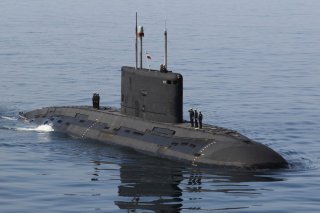The Backbone of Iran’s Navy Might Be Broken
Tehran might lack the ability to keep their Cold War-era Soviet submarines in running order.
Despite what propaganda from Tehran would like you to believe, Iran is almost entirely dependent on other countries' technology for their military machines. Whether we are talking about Iran’s formerly-Soviet tank designs, Russian training jets, or downright fake stealth fighters, there is a lot of copying going on in Iran.
From a capabilities point of view, one of Tehran’s lone bright spots is their Kilo-class submarines. The Kilo-class came from Soviet shipyards in the early 1980s. Unlike the Soviet Union and now Russia’s enormous “boomer” nuclear-powered ballistic missile submarines, the Kilos are diesel-electric and much smaller in size. They also lack vertical launch missile silos, and instead serve in an attack role, designed to prowl littoral waters for enemy surface ships and other submarines.
Though Iran’s Kilo submarines are certainly somewhat aged, they retain a number of features that would make them potent hunters in the Strait of Hormuz or in Iranian territorial waters, including relatively quiet propulsion, and potentially a sound-absorbent anechoic coating that helps silence normal operation.
Iran procured their Kilo-class submarines after the collapse of the Soviet Union. Desperate to inject badly needed cash into the Russian economy, Moscow sold a number of formerly Soviet weapons and weapon platforms abroad, and despite some international protest, Iran took delivery of three Kilo-class submarines.
And since introduction in Iran, Tehran’s Kilo submarines have represented the Crème de la crème of the Iranian Navy, despite their age—the Islamic Republic’s own designs just can’t compete. But, they might be out of commission for some time.
High and Dry
Recent reporting done by well-known naval experts indicates that Iran’s three Kilo-class submarines have been out of the water for about a month.
One of the first indications of Kilo-class problems occurred late last year, when one of Iran’s Kilo-class submarines was filmed during transport over land via semi-truck, possibly for serious repairs or intensive maintenance. The fact that all three of Iran’s Kilo submarines are out of the water at the same time, rather than in a staggered rotation, indicates that something is seriously wrong with their small Kilo fleet.
“One of the boats has been in a dry dock in Bandar Abbas since 2019, according to satellite photos,” explained the naval expert H. I. Sutton. “Another has been at the Shahid Darvish yard west of the city for months. And in mid-December, the third was also put in a dry dock in Bandar Abbas.”
Though the reasons for why the submarines that arguably form the backbone of Iran’s naval power are on land and not at sea is difficult to surmise with 100 percent certainty, it may be due to a lack of spare parts, a dearth of skilled technical knowledge related to repairs, financial and/or manpower constraints (perhaps due to the ongoing coronavirus pandemic) or a combination of all of the above.
Postscript
If Iran’s Kilo subs are serviceable or irreparable remains to be seen, though the Kilo’s breakdown does make recent claims from Tehran concerning a new nuclear-powered submarine in the works seem far-fetched.
Caleb Larson is a Defense Writer with The National Interest. He holds a Master of Public Policy and covers U.S. and Russian security, European defense issues, and German politics and culture.
Image: Reuters.

